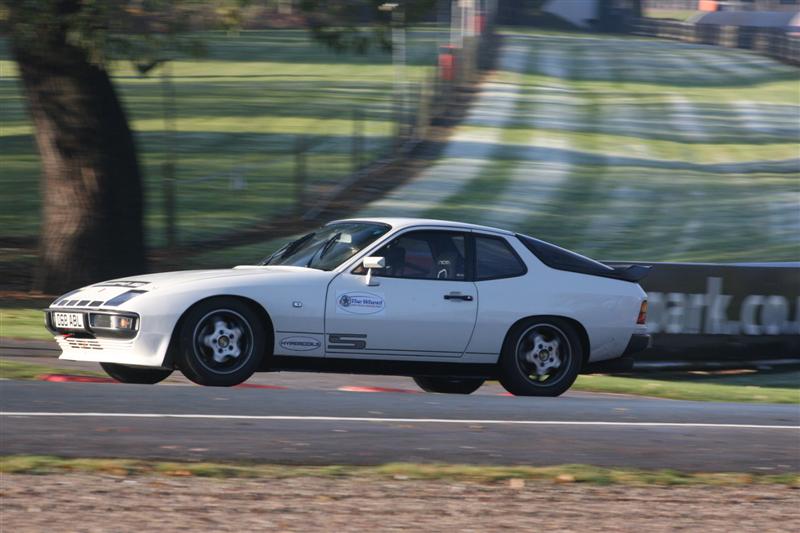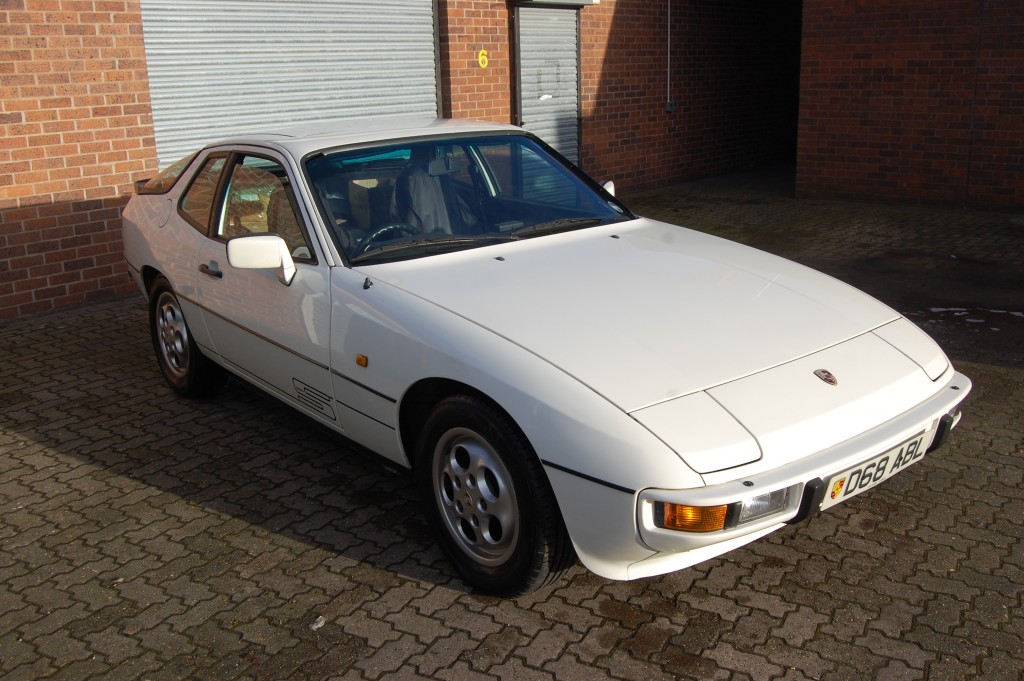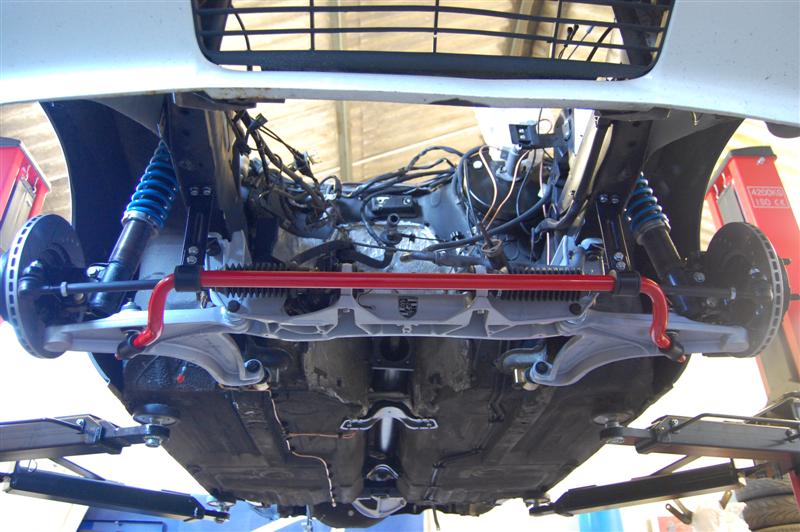924Srr27l
New member
My Front wishbones are at an approx 10-15 degree angle and I need to sort this out
as it's adversely affecting the handling
Standard Ride Height (Lower Wishbone level with the road)
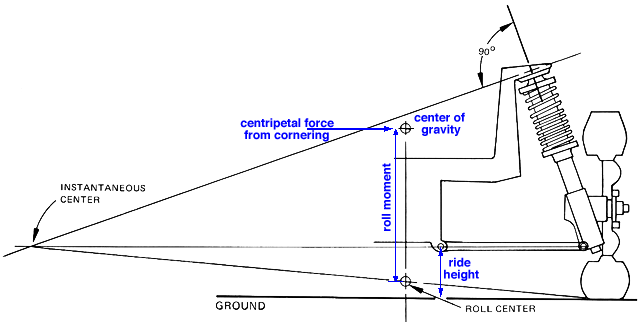
Lowered Ride Height (Wishbone angled upwards from the centre pivot point)
![. [FONT=verdana,geneva"] [FONT=verdana,geneva"]](/forum/styles/default/pcgb/space.gif)
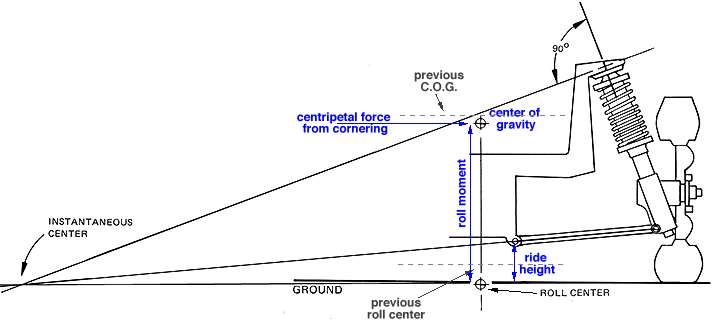
![. [FONT=verdana,geneva"] [FONT=verdana,geneva"]](/forum/styles/default/pcgb/space.gif)
![. [FONT=verdana,geneva"] [FONT=verdana,geneva"]](/forum/styles/default/pcgb/space.gif) The roll-center is determined by the geometry and is the point where the centerline of the car intersects with the line between the strut's pivot axis on the ground (near the tyre's outer edge usually), and the instantaneous center. The distance between the roll-center and the C.O.G. is the lever-arm that pushes the car sideways when there's a lateral weight-transfer due to cornering-G forces.
The roll-center is determined by the geometry and is the point where the centerline of the car intersects with the line between the strut's pivot axis on the ground (near the tyre's outer edge usually), and the instantaneous center. The distance between the roll-center and the C.O.G. is the lever-arm that pushes the car sideways when there's a lateral weight-transfer due to cornering-G forces.![. [FONT=verdana,geneva"] [FONT=verdana,geneva"]](/forum/styles/default/pcgb/space.gif)
![. [FONT=verdana,geneva"] [FONT=verdana,geneva"]](/forum/styles/default/pcgb/space.gif)
![. [FONT=verdana,geneva"] [FONT=verdana,geneva"]](/forum/styles/default/pcgb/space.gif)
![. [FONT=verdana,geneva"] [FONT=verdana,geneva"]](/forum/styles/default/pcgb/space.gif)
![. [FONT=verdana,geneva"] [FONT=verdana,geneva"]](/forum/styles/default/pcgb/space.gif) Note that the minimal amount that you lower the C.O.G. actually results in a much larger lowering of the roll-center. This increases the length of the moment-arm between the roll-center and COG. Meaning that for the same lateral-weight transfer at the same cornering-G, the car will roll MORE than before the lowering.
Note that the minimal amount that you lower the C.O.G. actually results in a much larger lowering of the roll-center. This increases the length of the moment-arm between the roll-center and COG. Meaning that for the same lateral-weight transfer at the same cornering-G, the car will roll MORE than before the lowering.
This has the detrimental effect of causing even MORE positive camber-gain on the outside tyre, causing it to ride on its edge even more and lose grip. The actual amount of reduction in lateral-weight transfer is minimal when lowering the C.O.G.; most of the weight-transfer is due to cornering-G, the body-roll is just in reaction to the weight-transfer.
So the trick is to minimize the negative effects of the positive camber-gain on the outside tyre when the body rolls. To keep the tyre flat on the ground, you can:
- add more static negative camber to account for body-roll, about -4.5 to -5.5 is optimal with stock suspension
- add stiffer springs and/or Anti Roll bars to reduce body-roll for the same amount of lateral weight-transfer
- Extend the BallJoint Pin length with a extension or use different Wishbones with longer Ball pins,![. [FONT=verdana,geneva"] [FONT=verdana,geneva"]](/forum/styles/default/pcgb/space.gif)
![. [FONT=verdana,geneva"] [FONT=verdana,geneva"]](/forum/styles/default/pcgb/space.gif)
![. [FONT=verdana,geneva"] [FONT=verdana,geneva"]](/forum/styles/default/pcgb/space.gif)
![. [FONT=verdana,geneva"] [FONT=verdana,geneva"]](/forum/styles/default/pcgb/space.gif) - Bump Steer also needs sorting with a spacer kit to re-position the Tie rod angle
- Bump Steer also needs sorting with a spacer kit to re-position the Tie rod angle![. [FONT=verdana,geneva"] [FONT=verdana,geneva"]](/forum/styles/default/pcgb/space.gif)
![. [FONT=verdana,geneva"] [FONT=verdana,geneva"]](/forum/styles/default/pcgb/space.gif)
![. [FONT=verdana,geneva"] [FONT=verdana,geneva"]](/forum/styles/default/pcgb/space.gif)
![. [FONT=verdana,geneva"] [FONT=verdana,geneva"]](/forum/styles/default/pcgb/space.gif)
Has anyone else also realised this issue and sorted it and if so How?
R
as it's adversely affecting the handling
Standard Ride Height (Lower Wishbone level with the road)

Lowered Ride Height (Wishbone angled upwards from the centre pivot point)
![. [FONT=verdana,geneva"] [FONT=verdana,geneva"]](/forum/styles/default/pcgb/space.gif)

![. [FONT=verdana,geneva"] [FONT=verdana,geneva"]](/forum/styles/default/pcgb/space.gif)
![. [FONT=verdana,geneva"] [FONT=verdana,geneva"]](/forum/styles/default/pcgb/space.gif) The roll-center is determined by the geometry and is the point where the centerline of the car intersects with the line between the strut's pivot axis on the ground (near the tyre's outer edge usually), and the instantaneous center. The distance between the roll-center and the C.O.G. is the lever-arm that pushes the car sideways when there's a lateral weight-transfer due to cornering-G forces.
The roll-center is determined by the geometry and is the point where the centerline of the car intersects with the line between the strut's pivot axis on the ground (near the tyre's outer edge usually), and the instantaneous center. The distance between the roll-center and the C.O.G. is the lever-arm that pushes the car sideways when there's a lateral weight-transfer due to cornering-G forces.![. [FONT=verdana,geneva"] [FONT=verdana,geneva"]](/forum/styles/default/pcgb/space.gif)
![. [FONT=verdana,geneva"] [FONT=verdana,geneva"]](/forum/styles/default/pcgb/space.gif)
![. [FONT=verdana,geneva"] [FONT=verdana,geneva"]](/forum/styles/default/pcgb/space.gif)
![. [FONT=verdana,geneva"] [FONT=verdana,geneva"]](/forum/styles/default/pcgb/space.gif)
![. [FONT=verdana,geneva"] [FONT=verdana,geneva"]](/forum/styles/default/pcgb/space.gif) Note that the minimal amount that you lower the C.O.G. actually results in a much larger lowering of the roll-center. This increases the length of the moment-arm between the roll-center and COG. Meaning that for the same lateral-weight transfer at the same cornering-G, the car will roll MORE than before the lowering.
Note that the minimal amount that you lower the C.O.G. actually results in a much larger lowering of the roll-center. This increases the length of the moment-arm between the roll-center and COG. Meaning that for the same lateral-weight transfer at the same cornering-G, the car will roll MORE than before the lowering.This has the detrimental effect of causing even MORE positive camber-gain on the outside tyre, causing it to ride on its edge even more and lose grip. The actual amount of reduction in lateral-weight transfer is minimal when lowering the C.O.G.; most of the weight-transfer is due to cornering-G, the body-roll is just in reaction to the weight-transfer.
So the trick is to minimize the negative effects of the positive camber-gain on the outside tyre when the body rolls. To keep the tyre flat on the ground, you can:
- add more static negative camber to account for body-roll, about -4.5 to -5.5 is optimal with stock suspension
- add stiffer springs and/or Anti Roll bars to reduce body-roll for the same amount of lateral weight-transfer
- Extend the BallJoint Pin length with a extension or use different Wishbones with longer Ball pins,
![. [FONT=verdana,geneva"] [FONT=verdana,geneva"]](/forum/styles/default/pcgb/space.gif)
![. [FONT=verdana,geneva"] [FONT=verdana,geneva"]](/forum/styles/default/pcgb/space.gif)
![. [FONT=verdana,geneva"] [FONT=verdana,geneva"]](/forum/styles/default/pcgb/space.gif)
![. [FONT=verdana,geneva"] [FONT=verdana,geneva"]](/forum/styles/default/pcgb/space.gif) - Bump Steer also needs sorting with a spacer kit to re-position the Tie rod angle
- Bump Steer also needs sorting with a spacer kit to re-position the Tie rod angle![. [FONT=verdana,geneva"] [FONT=verdana,geneva"]](/forum/styles/default/pcgb/space.gif)
![. [FONT=verdana,geneva"] [FONT=verdana,geneva"]](/forum/styles/default/pcgb/space.gif)
![. [FONT=verdana,geneva"] [FONT=verdana,geneva"]](/forum/styles/default/pcgb/space.gif)
![. [FONT=verdana,geneva"] [FONT=verdana,geneva"]](/forum/styles/default/pcgb/space.gif)
Has anyone else also realised this issue and sorted it and if so How?
R







